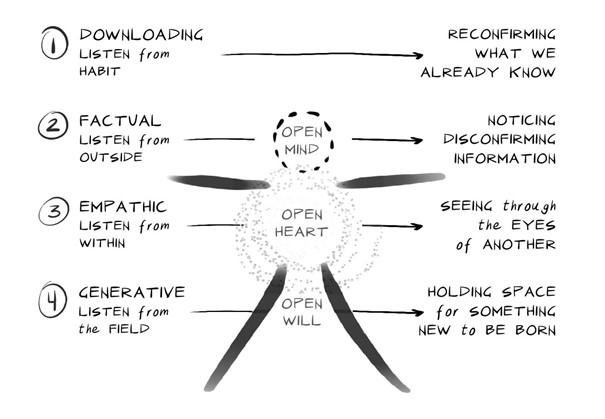Listening with our whole-selves while connecting to Source:
The ability to listen is an essential human quality; it catalyses our ability to be wise, is foundational to the quality of our relationships, and is core to how we manifest our Purpose in the world.
And yet listening is often overlooked in our rush to achieve more purposeful lives or more purposeful organizations.
Let’s explore four levels of listening (encompassing aspects of Scharmer’s Theory U, Deep Listening, Way of Council speaking and listening from the heart, non-violent communication, Bohm’s Dialogue, transformative listening, active & empathic listening, systemic and dialectic listening):
- Downloading (we are listening to information largely to confirm what we already know and in a factual way that is largely devoid of contextual relations e.g. train announcement, or someone speaking to us about day-to-day humdrum while we are half doing something else)
- Factual Listening (we are listening more attentively as there is specific information we sense as relevant to us e.g. train announcement specifically relating to a change to our schedule – our ears prick up and we listen more attentively, or a colleague is speaking to us about day-to-day stuff yet with new insights or updates that catch our attention.)
- Empathic listening (we are sensing into what is being communicated, the person is not speaking ‘to’ us, but ‘with’, as we are sensing how it feels for them as they ‘share’. We shift our perspective – if only momentarily – beyond our own judgements, habituations and framing because of our sensing into how the other person feels. We have opened ourselves up to listening beyond our ‘small self’ and started to relationally connect beyond ourselves. The other person senses this either consciously or unconsciously and the quality of communication is enriched as a result. It may still be about the day-to-day stuff, but we have intentionally chosen to enhance the quality of our listening through the depth of attention we are offering the ‘other’.)
- Generative Listening (we are conscious of our small ‘self’ judgements, personalities, habitual perspectives, emotional baggage, etc. and we allow ourselves to deepen our awareness, our presence, beyond this small ‘self’ as we open up to our deeper Self and the larger relational context or field we are in, by connecting with our hearts, guts, soma and intuition while opening up to the field/source/nature that our self-and-other relationship is immersed in. We sense the wider social, ecological and quantum field between us and beyond us. We give space and time for that which we sense is emerging within the generative field we are co-participating in. As we converse in this way, we open up more deeply to the wider relational context within and all around us – we presence life in an active and alive yet relaxed and patient way.)
‘When you operate from Listening 1 (downloading), the conversation reconfirms what you already knew. You reconfirm your habits of thought: “There he goes again!” When you operate from Listening 2 (factual listening), you disconfirm what you already know and notice what is new out there: “Boy, this looks so different today!” When you operate from Listening 3 (empathic listening), your perspective is redirected to seeing the situation through the eyes of another: “Boy, yes, now I really understand how you feel about it. I can sense it now too.” And finally, when you operate from Listening 4 (generative listening), you have gone through a subtle but profound change that has connected you to a deeper source of knowing, including the knowledge of your best future possibility and self.’ Otto Scharmer, leadership specialist

In learning to become more authentic, purposeful and soulful leaders, we become more self-aware of the different levels of listening we are applying throughout our daily discourse. It feels subtly different when we are engaged in generative listening; a ‘flow’ can be sensed in us and in the other people we relate with. We allow subtle synchronicities to come into our perceptual horizon, making wiser decisions as a result.
‘Attention is a moral act: it creates, brings aspects of things into being, in doing so makes others recede. What a thing is depends on who is attending to it and in what way.’ Iain McGilchrist, neuroscientist
Fundamentally it all boils down to our intention and the quality of our attention we are able to sustain during what can be stressful, fast-moving and distracting day-to-day environments.
Deep listening is a simple yet profound practice that helps us become more self-aware of the quality of our listening and speaking.
‘So when you are listening to somebody, completely, attentively, then you are listening not only to the words, but also to the feeling of what is being conveyed, to the whole of it, not part of it.’ Jiddu Krishnamurti, mystic
Deep Listening happens when we give our full attention to the moment, listening to what is being spoken without thinking what we are going to say in reply, giving our full attention uncluttered by judgement or opinions or distractions – presencing through listening – an attentive state of being that is open, alert, calm, and receptive.

We catch ourselves when we sense we are starting to get caught up in thoughts of past or future, or judgements about what the person is saying, or how it makes me feels. We move beyond empathic listening in that regard, as we go deeper than empathising with what the other is saying, into a deeper awareness of allowing ourselves to be clear, un-entangled by any feelings or thoughts that may spawn within us because of what is being said or the way it is being said, we notice how we feel and what is spawned in us, but then we bring ourselves back to the present moment, back to listening with our full attentiveness – undistracted and resonant within our hearts.
A simple practice of deep listening can be undertaken when one person speaks for 4 minutes and the other person listens generatively/deeply/fully, with no interruptions or verbal or bodily cues from the listener. The listener remains still yet attentive, maintaining warm gentle eye contact throughout. Then after four minutes, we swap and the other person speaks while the first person listens attentively.

Some general guidelines for undertaking this exercise of speaking and listening from the heart:
- Try not to come too much from the head or over-analysing what you are saying, just speak openly and naturally. Let go of rehearsing what you will say. Trust that would arises from within us is what is meant to be said.
- Speak in the first person – only ‘I’ – ‘my’ own experience, what ‘I’ and feeling. Avoid using ‘you’ or ‘they’ or projecting opinions/judgements on others.
- Be self-aware, notice if you are rambling, and notice how coherent you are feeling while speaking and listening – be aware of the sense in your heart and gut.
- Listen without judgement and opinions – be self-aware of when judging or forming opinions and learn to let go, so you can be fully present. If your attention wonders, gently bring it back to focusing on the person you are listening to, while maintaining warm eye contact, without any verbal or non-verbal cues or body gestures. Remain still, relaxed, present and fully attentive. Enjoy.


